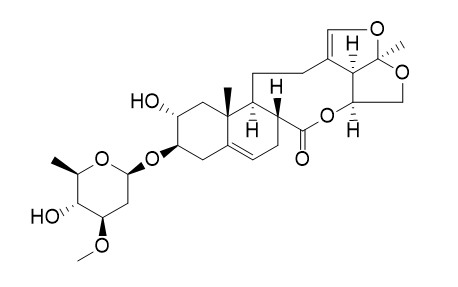Glaucoside A
Anticancer. Glaucoside A was evaluated against the HT-29 and HCT 116 human colon cancer cell lines.
Inquire / Order:
manager@chemfaces.com
Technical Inquiries:
service@chemfaces.com
Tel:
+86-27-84237783
Fax:
+86-27-84254680
Address:
1 Building, No. 83, CheCheng Rd., Wuhan Economic and Technological Development Zone, Wuhan, Hubei 430056, PRC
Providing storage is as stated on the product vial and the vial is kept tightly sealed, the product can be stored for up to
24 months(2-8C).
Wherever possible, you should prepare and use solutions on the same day. However, if you need to make up stock solutions in advance, we recommend that you store the solution as aliquots in tightly sealed vials at -20C. Generally, these will be useable for up to two weeks. Before use, and prior to opening the vial we recommend that you allow your product to equilibrate to room temperature for at least 1 hour.
Need more advice on solubility, usage and handling? Please email to: service@chemfaces.com
The packaging of the product may have turned upside down during transportation, resulting in the natural compounds adhering to the neck or cap of the vial. take the vial out of its packaging and gently shake to let the compounds fall to the bottom of the vial. for liquid products, centrifuge at 200-500 RPM to gather the liquid at the bottom of the vial. try to avoid loss or contamination during handling.
J Am Soc Mass Spectrom.2021, 32(9):2451-2462.
J of Essential Oil Research2019, 1677272
Front Plant Sci.2020, 11:630.
J Clin Transl Hepatol.2023, 11(4):863-876.
Phytomedicine.2020, 153440.
Hanoi University of Pharmacy2023, 14(1):30-39.
Biomed Pharmacother.2022, 145:112410.
J Cell Mol Med.2020, 24(21):12308-12317.
Molecules.2023, 28(9):3685.
BMC Complement Altern Med.2018, 18(1):221
Related and Featured Products
Indian J Pharmacol . Jan-Feb 2016;48(1):99-100.
Cytotoxic activity of a glaucoside from Eugenia jambolana against MCF-7 cells[Pubmed:
26997737]
Magn Reson Chem . 2011 Feb;49(2):83-9
Glaucasides A-C, three saikosaponins from Atriplex glauca L. var. ifiniensis (Caball) Maire[Pubmed:
21254229]
From the roots of Atriplex glauca L. var. ifiniensis (Caball) Maire (syn. of Atriplex parvifolia Lowe var. genuina Maire), three new saikosaponins designated as glaucasides A-C (1-3) were isolated together with the known 3-O-β-D-glucopyranosyl-(1 → 2)-β-D-galactopyranosyl-saikogenin F (4). The structures of the new compounds were elucidated by extensive analysis of one-dimensional and two-dimensional NMR spectroscopy, FABMS, HR-ESIMS and chemical evidence as 13β,28-epoxy-16β,21β-dihydroxyolean-11-en-3β-yl O-β-D-[2-O-sulfate]-glucopyranosyl-(1 → 2)-α-L-arabinopyranoside (1), 13β,28-epoxy-16β,21β-dihydroxyolean-11-en-3β-yl O-β-D-[2-O-sulfate]-glucopyranosyl-(1 → 2)-α-L-arabinopyranosyl 21-O-{4-(secbutylamido)-butanoyl ester} (2) and 3-O-β-D-glucopyranosyl-(1 → 2)-β-D-galactopyranosyl saikogenin G (3). The cytotoxic activities of these compounds were evaluated against the HT-29 and HCT 116 human colon cancer cell lines.
Steroids . 2008 Jul;73(6):629-36.
Steroidal glycosides from the roots of Cynanchum amplexicaule Sieb. et Zucc[Pubmed:
18343471]
Seven new steroidal glycosides (amplexicosides A (4), B (7), C (8), D (9), E (10), F (11), and G (12)), along with six known compounds (cynatratoside A (1), tylophoside A (2), cynatratoside B (3), glaucogenin A (5), Glaucoside A (6), and hancoside A (13)) were isolated from the 95% ethanol extract of the roots of Cynanchum amplexicaule (Sieb. et Zucc.). Their structures were determined based on spectral and chemical evidence. Compound 12 has a 14, 15-secopregnane-type skeleton aglycone, which has not been reported in literature.



